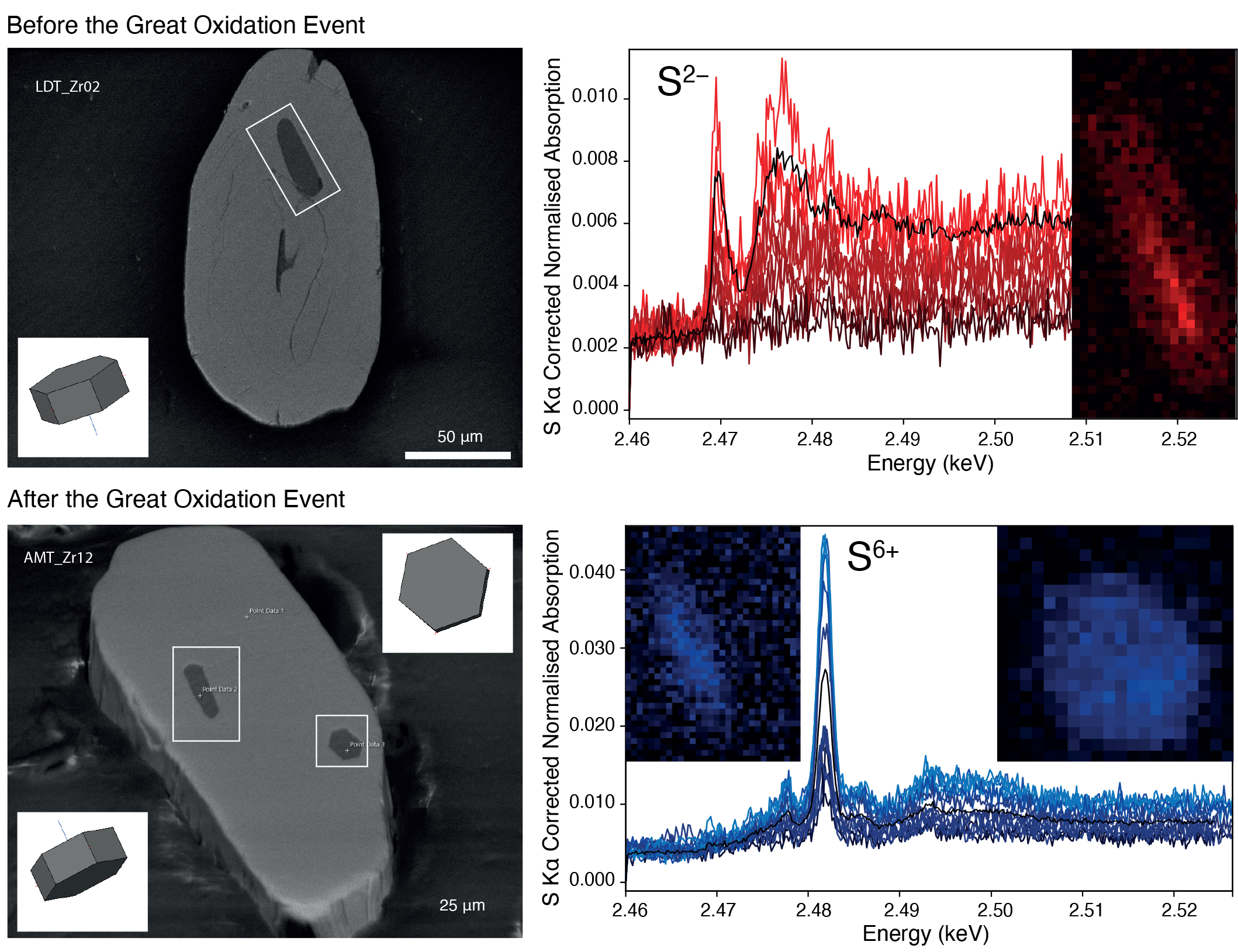- Home
- News
- General News
- New research reveals...
New research reveals Earth's ancient 'breath'
31-08-2023
Scientists have unveiled important information on The Great Oxidation Event by studying apatite inclusions in zircon crystals from old magmas at the ESRF’s ID21 beamline. The results are published in Nature Geosciences.
Around 2.4 billion years ago, a pivotal moment in Earth's history took place: The Great Oxidation Event. During this period, a significant amount of oxygen accumulated in the atmosphere. This surge in oxygen production led to a dramatic shift in the composition of the atmosphere, altering the chemistry of the planet. The event marked a turning point as oxygen levels rose, enabling the development of more complex multicellular life forms and fundamentally reshaping Earth's ecosystems.
Plate tectonics are an effective mechanism for the cycling and interchange of elements among Earth's surface, atmosphere and mantle. As mountains undergo weathering and erosion through interactions with water and the atmosphere, they break down into sediments. These sediments are then partially returned to the mantle through subduction processes (one tectonic plate sinking beneath another). The formation of magmas in the mantle above subduction zones provides a unique opportunity to explore how the atmosphere could have impacted the mantle by assimilating materials from subducted sediments, offering insights into this intriguing geological relationship.
Scientists have long tried to study the interaction between atmosphere and the Earth’s mantle. The mission is already complicated to accomplish in the modern Earth, and even more so in the early Earth, when the atmosphere and plate tectonics were changing at rapid rates. Now, a team led by the University of Montpellier and University of Portsmouth have found a way to overcome obstacles by studying apatite inclusions in zircon from subduction zones.
“In 2017, a paper on the mineral apatite unveiled that when it grows at reduced conditions, meaning there is little or no free oxygen for chemical reactions, its sulphur would show a very specific signature. However, if it crystallised in oxidised conditions, the sulphur inside the apatite would look very different. This means that apatite is a proxy for redox conditions,” explains Hugo Moreira, a CNRS postdoctoral researcher at the University of Montpellier and first author of the paper.
Moreira and colleagues decided to explore inclusions of phosphate-mineral apatite in zircon grains that are crystallised in magmas formed in an ancient subduction zone, and measured their sulphur valence speciation using X-ray absorption near-edge structure (XANES) at the ESRF’s ID21 beamline. The team had never used the ESRF before, so guidance in the experiment from the ESRF scientists was crucial. However, the timing was not the best: “The experiment was the first one we carried out in the middle of the COVID-19 pandemic, in remote mode, but it served as a testbed for the future experiments we did in remote,” explains Marine Cotte, scientist in charge of the beamline. Moreira adds: “It was complicated because of all the logistical issues, and because we’d never used a synchrotron before, but the results were exactly what we needed, and this is thanks to the expertise and professionalism of the staff, in very complex circumstances.”
Sulphur incorporation and speciation in apatite is intrinsically dependent on the oxygen fugacity of the magma and therefore ideal for assessing the oxidation state during the evolution of magmatic systems. “Using apatite inclusions in zircons rather than apatite from the rock matrix was paramount, as the inclusions had been shielded by the extremely robust zircon crystals, preserving their original composition,” explains Moreira.
Fig. 1: Sulphur speciation in apatite inclusions in zircon acquired at the ESRF’s ID21 beamline. The spectrum of sulphur changed from reduced (S2-) to oxidised (S6+) from pre- to post- Great Oxidation Event. Authors argue that atmospherically-altered sediments infiltrated the mantle and changed the redox state of magmas.
The experiment results show that apatite inclusions in zircons from magmas that crystallised prior to the Great Oxidation Event have a relatively reduced sulphur redox state, whereas after the Great Oxidation Event they are more oxidised (Figure 1). The analysis of the zircon shows that these magmas shared a similar source and that the younger samples had incorporated a sediment component. Overall, the clear implication is that sediments affected by an increasingly oxidised atmosphere modified the mantle and shifted the fugacity of magmas towards more oxidised conditions.
“Our study shows that investigating apatite inclusions in zircon using synchrotron X-rays is a powerful tool to constrain a critical magma parameter,” concludes Moreira.
The next step for the team is to study other magmas that crystallised in key periods of Earth’s history, such as the Neoproterozoic Oxidation Event (beginning 850 million years ago) and when the first signs of oxygen emerged in the Archaean period.
Reference:
H. Moreira et al., Nature Geosciences, 31 Aug. 2023; https://doi.org/10.1038/s41561-023-01258-4




